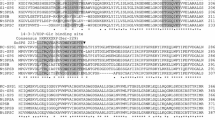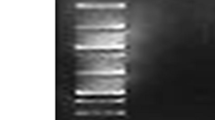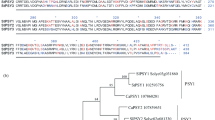Abstract
A polymerase chain reaction product (PKIN503) was amplified from potato (Solanum tuberosum) cv. Désirée using oligonucleotide primers with sequences which are highly conserved in the plant sucrose non-fermenting 1 (SNF1)-related protein kinase gene family. Southern blot analysis showed the presence of 5–10 SNF1-related genes in the potato genome. PKIN503 was used to screen a tuber cDNA library and a genomic library, and one cDNA and five genomic clones were isolated. The nucleotide sequences of a portion of all five genomic clones were shown to be identical and only one, pgPKIN1, was analysed further. The cDNA was found to be truncated at the 5′ end but the cDNA and genomic sequences contained only 15 substitutions, two of which resulted in changes in the derived amino acid sequence. PKIN1 was shown to encode an Mr 57854 protein with 61–70% sequence similarity with other plant SNF1-related protein kinases. Northern blot analysis revealed some tissue-specific differences in PKIN1 transcript levels, the lowest being detected in leaves and the highest in stolons. However, much greater differences were found in SNF1-related activity, which was measured using a phosphorylation assay with a substrate peptide which has been shown previously to be phosphorylated by plant SNF1-related protein kinases. Activity decreased by almost 80% during development from stolons to mature tubers but it increased about seven-fold during the first seven days of storage after harvesting, before decreasing again. However, activity was highest in mini-tubers, where the levels were 37 times greater than those in mature tubers from a pot-grown plant. Transcript levels in these tissues were approximately equal, clear evidence that SNF1-related protein kinase activity in potato is regulated, in part, post-transcriptionally.
Similar content being viewed by others
References
Alderson A, Sabelli PA, Dickinson JR, Cole D, Richardson M, Kreis M, Shewry PR, Halford NG: Complementation of snf1, a mutation affecting global regulation of carbon metabolism in yeast, by a plant protein kinase cDNA. Proc Natl Acad Sci USA 88: 8602-8605 (1991).
Ball KL, Barker JHA, Halford NG, Hardie DG: Immunological evidence that HMG-CoA reductase kinase-A is the cauliflower homologue of the RKIN1 subfamily of plant protein kinases. FEBS Letters 377: 189-192 (1995).
Ball KL, Dale S, Weekes J, Hardie DG: Biochemical characterisation of two forms of 3-hydroxy-3-methylglutaryl-CoA reductase kinase from cauliflower (Brassica oleracea). Eur J Biochem 219: 743-750 (1994).
Barker JHA, Slocombe SP, Ball KL, Hardie DG, Shewry PR, Halford NG (1996): Evidence that barley 3-hydroxy-3-methylglutaryl-Coenzyme A reductase kinase is a member of the sucrose nonfermenting-1-related protein kinase family. Plant Physiol, in press (1997).
Bradford M: A rapid and sensitive method for the quantitation of microgram quantities of protein utilising the principle of protein-dye binding. Anal Biochem 72: 248-254 (1976).
Carling D, Aguan K, Woods A, Verhoeven AJM, Beri RK, Brennan CH, Sidebottom C Davison MD, Scott J: Mammalian AMP-activated protein kinase is homologous to yeast and plant protein kinases involved in the regulation of carbon metabolism. J Biol Chem 269: 11442-11448 (1994).
Carling D, Clarke PR, Zammit VA, Hardie DG: Purification and characterisation of the AMP-activated protein kinase - co-purification of acetyl-CoA carboxylase and 3-hydroxy-3-methylglutaryl CoA reductase kinase activity. Eur J Biochem 186: 129-136 (1989).
Carlson M, Osmond BC, Botstein D: Mutants of yeast defective in sucrose utilisation. Genetics 98: 25-40 (1981).
Carlson M, Osmond BC, Neigeborn L, Botstein D: Asuppresser of snf1mutations causes constitutive high level invertase synthesis in yeast. Genetics 107: 19-32 (1984).
Celenza JL, Carlson M: Ayeast gene that is essential for release from glucose repression encodes a protein kinase. Science 233: 1175-1180 (1986).
Celenza JL, Carlson M: Mutational analysis of the Saccharomyces cerevisiaeSNF1 protein kinase and evidence for functional interaction with the SNF4 protein. Mol Cell Biol 9: 5034-5044 (1989).
Clarke PR, Hardie DG: Regulation of HMG-CoA reductase: identification of the site phosphorylated by the AMP-activated protein kinase in vitroand in intact rat liver. EMBO J 9: 2439- 2446 (1990).
Davies SP, Carling D, Hardie DG: Tissue distribution of the AMP-activated protein kinase, and lack of activation by cyclic AMP-dependent protein kinase, studies using a specific and sensitive peptide assay. Eur J Biochem 186: 123-128 (1989).
Davies SP, Carling D, Munday MR, Hardie, DG: Diurnal rhythm of phosphorylation of rat-liver acetyl-CoA carboxylase by the AMP-activated protein kinase, demonstrated using freeze-clamping - effects of high-fat diets. Eur J Biochem 203: 615-623 (1992).
Davies SP, Sim ATR, Hardie DG: Location and function of three sites phosphorylated on rat acetyl-CoA carboxylase by the AMP-activated protein kinase. Eur J Biochem 187: 183- 190 (1990).
Gancedo JM: Carbon catabolite repression in yeast. Eur J Biochem 206: 297-313 (1992).
Genetics Computer Group: Program Manual for theWisconsin Package, Version 8, September 1994. GCG 575 Science Drive, WI 53711, USA (1991).
Grierson CS: Transcriptional Regulators of Patatin Gene Expression. PhD thesis, Darwin College, University of Cambridge, UK (1992).
Halford NG: Library screening with heterologous and homologous probes. In: Foster GD, Twell D (eds) Plant Gene Isolation, pp. 103-123. John Wiley, Chichester, UK (1996).
Halford NG, Man AL, Barker JHA, Monger W, Shewry PR, Smith AM, Purcell PC: Investigating the role of plant SNF1-related protein kinases. Biochem Soc Trans 22: 953-957 (1994).
Halford NG, Vicente-Carbajosa J, Shewry PR, Hannappel U, Kreis M: Molecular analyses of a barley multigene family homologous to the yeast protein kinase gene SNF1. Plant J 2: 791-797 (1992).
Hanks SK, Quinn AM, Hunter T: The protein kinase family: conserved features and deduced phylogeny of the catalytic domains. Science 241: 42-52 (1988).
Hanks SK, Hunter T: The eukaryotic protein kinase superfamily. In: Hardie G, Hanks S (eds) The Protein Kinase Factsbook I, pp. 7-47. Academic Press, London (1995).
Hannappel U, Vicente-Carbajosa J, Barker JHA, Shewry PR, Halford NG: Differential expression of two barley SNF1-related protein kinase genes. Plant Mol Biol 27: 1235-1240 (1995).
Hardie DG: The structure and function of the protein kinases: a survey. In: Shewry PR, Halford NG, Hooley R (eds) Protein Phosphorylation in Plants, pp. 3-15. Clarendon Press, Oxford (1996).
Hardy TA, Huang D, Roach PJ: Interactions between cAMPdependent and SNF1 protein kinases in the control of glycogen accumulation in Saccharomyces cerevisiae. J Biol Chem 269: 27907-27913 (1994).
Holdsworth MJ, Grierson C, Schuch W, Bevan M: DNAbinding properties of cloned TATA-binding protein from potato tubers. Plant Mol Biol 19: 455-462 (1992).
Hunter T: 1001 protein kinases redux - towards 2000. Semin Cell Biol 5: 367-376 (1994).
Kimura M: The Neutral Theory of Molecular Evolution. Cambridge University Press, Cambridge, UK (1980).
Le Guen L, Thomas M, Bianchi M, Halford NG, Kreis M: Structure and expression of a gene from Arabidopsis thalianaencoding a protein kinase related to the SNF1sub-family of protein kinases. Gene 120: 249-254 (1992)
Logemann J, Schell J, Willmitzer L: Improved method for the isolation of RNAfrom plant tissues. Anal Biochem 163: 16-20 (1987).
Mackintosh RW, Davies SP, Clarke PR, Weekes J, Gillespie JG, Gibb BJ, Hardie DG: Evidence for a protein kinase cascade in higher plants. Eur J Biochem 209: 923-931 (1992).
Munday MR, Campbell DG, Carling D, Hardie DG: Identi-fication by amino acid sequencing of three major regulatory phosphorylation sites on rat acetyl-CoA carboxylase. Eur J Biochem 175: 331-338 (1988).
Muranaka T, Banno H, Machida Y: Characterisation of the tobacco protein kinase NPK5, a homologue of Saccharomyces cerevisiae SNF1that constitutively activates expression of the glucose-repressible SUC2gene for a secreted invertase of S. cerevisiae. Mol Cell Biol 14: 2958-2965 (1994).
Neigeborn L, Carlson M: Genes affecting the regulation of gene expression by glucose repression in Saccharomyces cerevisiae. Genetics 108: 845-858 (1984).
Sabelli PA, Shewry PR: Characterisation and organisation of gene families at the Gli-1loci of bread and durum wheats by restriction fragment analysis. Theor Appl Genet 83: 209-216 (1991).
Sim ATR, Hardie DG: The low activity of acetyl-CoA carboxylase in basal and glucagon-stimulated hepatocytes is due to phosphorylation by the AMP-activated protein kinase and not cyclic AMP-dependent protein kinase. FEBS Lett 233: 294-298 (1988).
Thompson-Jaeger S, Francois J, Gaughran JP and Tatchell K: Deletion of SNF1affects the nutrient response of yeast and resembles mutations which activate the adenylate cyclase pathway. Genetics 129: 697-706 (1991).
Woods A, Munday MR, Scott J, Yang X, Carlson M, Carling D: Yeast SNF1 is functionally related to mammalian AMPactivated protein kinase and regulates acetyl-CoA carboxylase in vivo. J Biol Chem 269: 19509-19515 (1994).
Author information
Authors and Affiliations
Rights and permissions
About this article
Cite this article
Man, A.L., Purcell, P.C., Hannappel, U. et al. Potato SNF1-related protein kinase: molecular cloning, expression analysis and peptide kinase activity measurements. Plant Mol Biol 34, 31–43 (1997). https://doi.org/10.1023/A:1005765719873
Issue Date:
DOI: https://doi.org/10.1023/A:1005765719873




